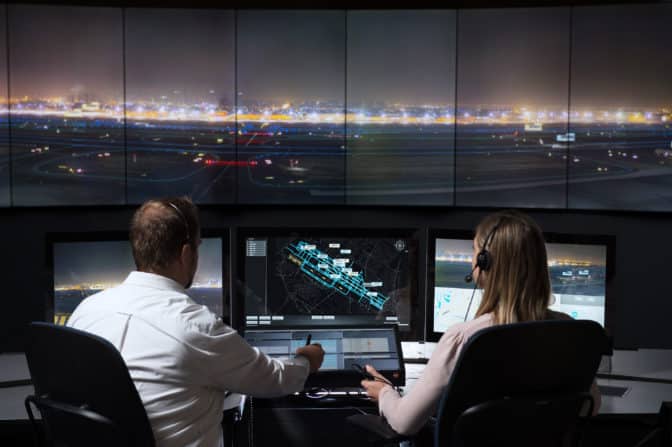Planes taxiing for long periods due to ground traffic — or circling the airport while awaiting clearance to land — don’t just make travelers impatient. They burn fuel unnecessarily, harming the environment and adding to airlines’ costs.
Searidge Technologies, based in Ottawa, Canada, has created AI-powered software to help the aviation industry avoid such issues, increasing efficiency and enhancing safety for airports.
Its Digital Tower and Apron solutions, powered by NVIDIA GPUs, use vision AI to manage traffic control for airports and alert users of safety concerns in real time. Searidge enables airports to handle 15-30% more aircraft per hour and reduce the number of tarmac incidents.
The company’s tech is used across the world, including at London’s Heathrow Airport, Fort Lauderdale-Hollywood International Airport in Florida and Dubai International Airport, to name a few.
In June, Searidge’s Digital Apron and Tower Management System (DATMS) went operational at Hong Kong International Airport as part of an initial phase of the Airport Authority Hong Kong’s large-scale expansion plan, which will bring machine learning to a new, integrated airport operations center.
In addition, Searidge provides the Civil Aviation Department of Hong Kong’s air-traffic control systems with next-generation safety enhancements using its vision AI software.
The deployment in Hong Kong is the industry’s largest digital platform for tower and apron management — and the first collaboration between an airport and an air-navigation service provider for a single digital platform.
Searidge is a member of NVIDIA Metropolis, a partner program focused on bringing to market a new generation of vision AI applications that make the world’s most important spaces and operations safer and more efficient.
Digital Tools for Airports
The early 2000s saw massive growth and restructuring of airports — and with this came increased use of digital tools in the aviation industry.
Founded in 2006, Searidge has become one of the first to bring machine learning to video processing in the aviation space, according to Pat Urbanek, the company’s vice president of business development for Asia Pacific and the Middle East.
“Video processing software for air-traffic control didn’t exist before,” Urbanek said. “It’s taken a decade to become mainstream — but now, intelligent video and machine learning have been brought into airport operations, enabling new levels of automation in air-traffic control and airside operations to enhance safety and efficiency.”
DATMS’s underlying machine learning platform, called Aimee, enables traffic-lighting automation based on data from radars and 4K-resolution video cameras. Aimee is trained to detect aircraft and vehicles. And DATMS is programmed based on the complex roadway rules that determine how buses and other vehicles should operate on service roads across taxiways.
After analyzing video data, the AI-enabled system activates or deactivates airports’ traffic lights in real time, based on when it’s appropriate for passenger buses and other vehicles to move. The status of each traffic light and additional details can also be visualized on end-user screens in airport traffic control rooms.
“What size is an aircraft? Does it have enough space to turn on the runway? Is it going too fast? All of this information and more is sent out over the Searidge Platform and displayed on screen based on user preference,” said Marco Rueckert, vice president of technology at Searidge.

The same underlying technology is applied to provide enhanced safety alerts for aircraft departure and arrival. In real time, DATMS alerts air traffic controllers of safety-standard breaches — taking into consideration clearances for aircraft to enter a runway, takeoff or land.
Speedups With NVIDIA GPUs
Searidge uses NVIDIA GPUs to optimize inference throughput across its deployments at airports around the globe. To train its AI models, Searidge uses an NVIDIA DGX A100 system.
“The NVIDIA platform allowed us to really bring down the hardware footprint and costs from the customer’s perspective,” Rueckert said. “It provides the scalability factor, so we can easily add more cameras with increasing resolution, which ultimately helps us solve more problems and address more customer needs.”
The company is also exploring the integration of voice data — based on communication between pilots and air-traffic controllers — within its machine learning platform to further enhance airport operations.
Searidge’s Digital Tower and Apron solutions can be customized for the unique challenges that come with varying airport layouts and traffic patterns.
“Of course, having aircraft land on time and letting passengers make their connections increases business and efficiency, but our technology has an environmental impact as well,” Urbanek said. “It can prevent burning of huge amounts of fuel — in the air or at the gate — by providing enhanced efficiency and safety for taxiing, takeoff and landing.”
Watch the latest GTC keynote by NVIDIA founder and CEO Jensen Huang to discover how vision AI and other groundbreaking technologies are shaping the world:
Feature video courtesy of Dubai Airports.